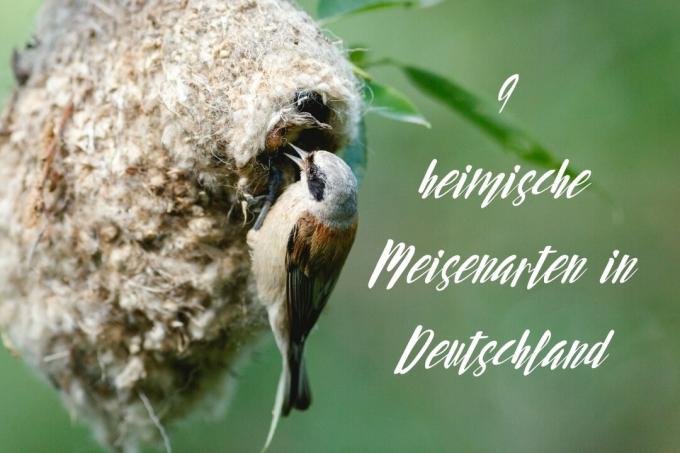
table of contents
- Bearded Tit - Panurus biarmicus
- Tasmanian tit - Remiz pendulinus
- Blue tit - Parus caeruleus
- Great crested tit - Parus cristatus
- Great tit - Parus major
- Tail tit - Aegithalos caudatus
- Marsh tit - Parus palustris
- Coal Tit - Parus ater
- Willow tit - Parus montanus
- frequently asked Questions
The blue tit and the great tit are best known in Germany. But there are a few other titmouse species that are native here. They are presented in this post.
In a nutshell
- Tits are often cave breeders
- live everywhere in gardens, parks and forests or in wetlands
- belong to the smallest bird species
- no migratory birds, at most partial migrants
- all tit species move very skillfully in the branches and are often nimble and restless
Bearded Tit - Panurus biarmicus
The bearded tit does not actually belong to the titmouse, instead it is one of the so-called thrush tit, which is mostly native to Asia. It is named after the black "beard" on the bird's face.
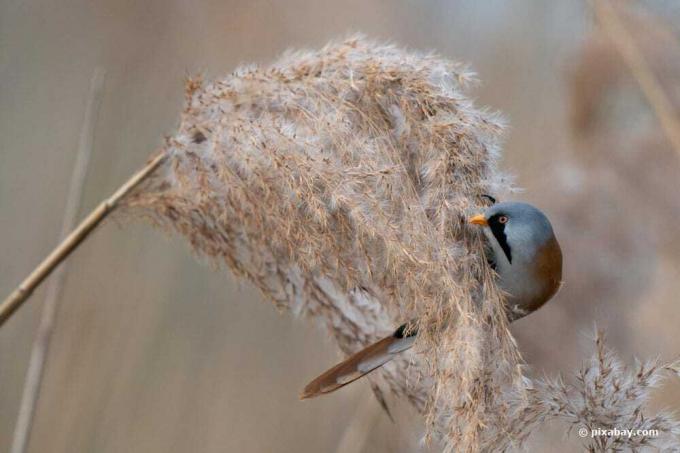
- Size: 14 to 15 cm
- Characteristics: Plumage predominantly cinnamon brown, head gray, bill strikingly orange, tail very long, females with a rather brownish bill, less conspicuous plumage markings, no beard, young birds similar to the female with dark markings on the top and the Tail sides
- Occurrence: in Germany rather seldom, most likely in northern Germany, breeds in water in reed stands
- Food:insects and reed seeds
- Brood: April to July, with suitable weather up to 3 broods per year, 4 to 6 eggs, no cave breeder, often nests in colonies, nest is made in the reeds, just above the ground or the water surface
Tasmanian tit - Remiz pendulinus
This tit does not belong to the tit family either, but to the bag tit. The bag nest hanging from the tips of branches is typical of this species. In terms of appearance, they resemble the red-backed shrike.
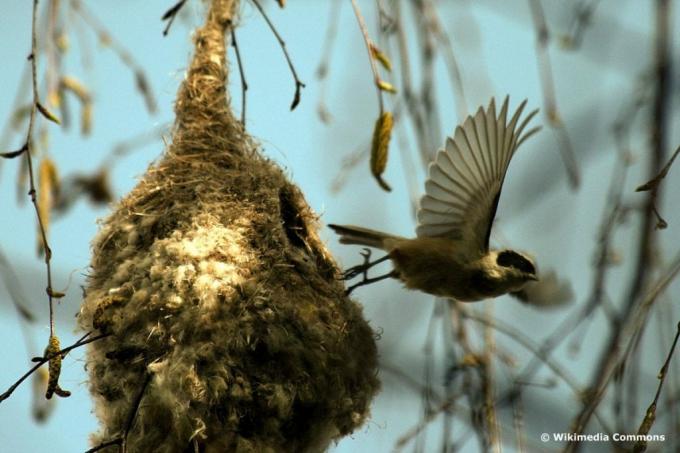
- Height and weight: 10 to 12 cm, about 20 g
- Characteristics: chestnut brown back, otherwise mostly gray, belly a bit yellowish, conspicuous black face mask around the eyes, gray beak, sex differences hardly noticeable, female pu-titmouse less contrasting, young birds without Face mask
- Occurrence: seldom in Germany, more often in eastern Central Europe, nesting in riparian forests, bank thickets with willow or poplar stands, rarely in winter
- Food: Insects, spiders and, in winter, seeds
- Brood: April to June, one brood per year, 5 to 8 eggs, a bag nest with an entrance tube is often built over the water, it consists of cobwebs, plant fibers and seed wool
Note: The potty tit likes to nest in colonies.
Blue tit - Parus caeruleus
Blue tits can often be recognized at first glance, there is no other bird with similar plumage colors. This little tit is often found in gardens, it moves very skillfully, even upside down.

- Height and weight: 10 to 12 cm, 8 to 11 g
- Characteristics: blue-yellow plumage, blue top of the head, black eye stripes, blue wings, yellow belly, hardly any sex differences, females a little paler, young birds even lighter in color
- Occurrence: common everywhere, breeds in gardens, forests or parks, preferably oak stands
- Food: Insects and their stages of development, spiders, fine seeds, small nuts, like to come to the bird feeder in winter
- Brood: April to June, depending on the weather, one to two broods per year, 6 to 12 eggs, cave breeders in tree hollows, nesting boxes, wall holes or other suitable locations
Great crested tit - Parus cristatus
Typical and eponymous for this tit is the eye-catching hood. The crested tit is indigenous to us, but it is less common than other tit species.
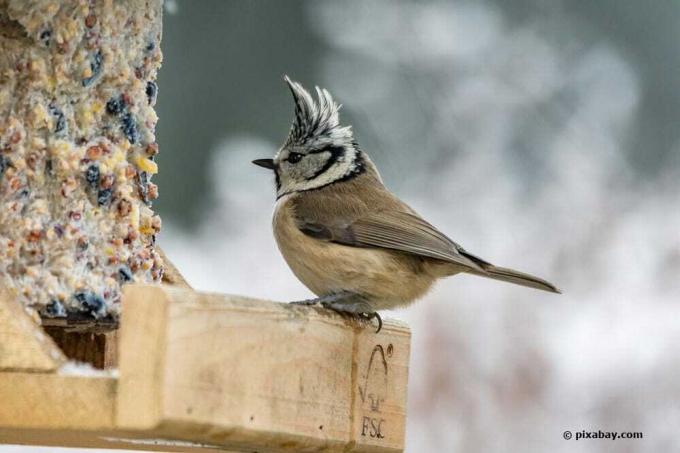
- Height and weight: 11 to 12 cm, 10 to 12 g
- Characteristics: black and white grained hood, brown plumage, hardly any gender differences, young birds gray, hood less noticeable
- Occurrence: very true to location, in forests, especially in coniferous forests, but also in deciduous forests
- Food: Insects, larvae, spiders, seeds of conifers, smaller nuts
- Brood: April to June, one or two broods per year, 4 to 8 eggs, nests in tree hollows, tree stumps, also colonizes old nests of squirrels, the brood hole can build itself
Note: Sometimes this tit also nests in inhabited bird of prey nests.
Great tit - Parus major
The great tit is one of the largest native tit species and is also the most common native tit. The black and white head is striking.
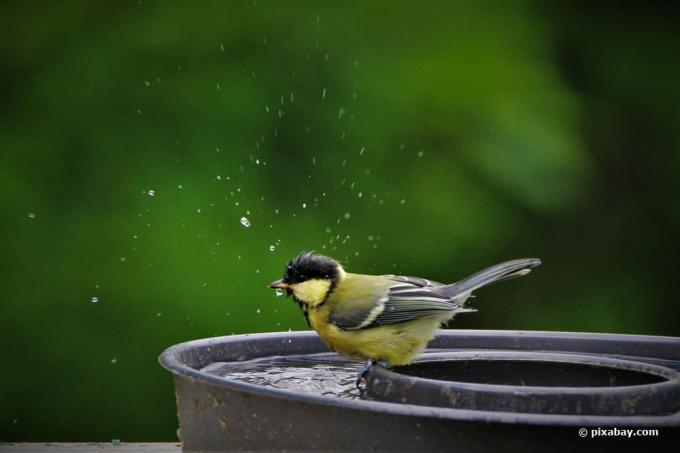
- Height and weight: 13 to 15 cm, 14 to 22 g
- Characteristics: yellow basic color of the plumage, black longitudinal stripes in the middle of the breast, greenish-bluish wings, Females with thinner center line, young birds still black-brown on the head, yellow cheeks, less contrasting colored
- Occurrence: everywhere often
- Food: Insects, larvae, nuts, seeds, spiders
- Brood: April to July, one to two broods per year, 6 to 12 eggs, nests in tree hollows, nest boxes and wall holes
Tail tit - Aegithalos caudatus
The tail tit is not closely related to the actual tit, it belongs to the tail tit family. The long tail is typical and eponymous for this songbird.

- Height and weight: 13 to 16 cm, 7 to 10 g
- Characteristics: Depending on the subspecies with white or black and white striped head, plumage rich in contrasting gray, white, black and red-brown in color, hardly any sex differences, young birds still with shorter tails and darker cheeks
- Occurrence: as very sociable, often out and about in small groups, partial migrants, in winter often at bird feeders, otherwise Native in forests close to water also in gardens and parks rich in undergrowth, at field edges or in Bog trees
- Food: Insects and spiders, seeds in winter
- Brood: April to June, one or two broods per year, 8 to 12 eggs, no cave breeder, builds egg-shaped nests in trees or high bushes, conspecifics support each other in rearing young animals
Marsh tit - Parus palustris
Contrary to its name, the swamp tit is not only native to moist locations. She also visits gardens and parks, comes to bird feeders and can be seen hiding seeds.

- Size: 11 to 13 cm
- Characteristics: Appearance rather gray, less colorful than other tits, light cheeks, black top of the head, hardly any gender differences, young birds with matt black top of the head
- Occurrence: in deciduous and mixed forests, gardens and parks, also on the edges of overgrown fields, although often rarely seen everywhere
- Food: Insects, larvae, spiders, thistle, herb and grass seeds
- Brood: April to May, one brood per year, 7 to 9 eggs, nests in tree hollows, in knotholes or between tree roots, only rarely accepts nest boxes
Coal Tit - Parus ater
This tit is similar to the great tit, but is paler and smaller. It is the smallest native species of titmouse.
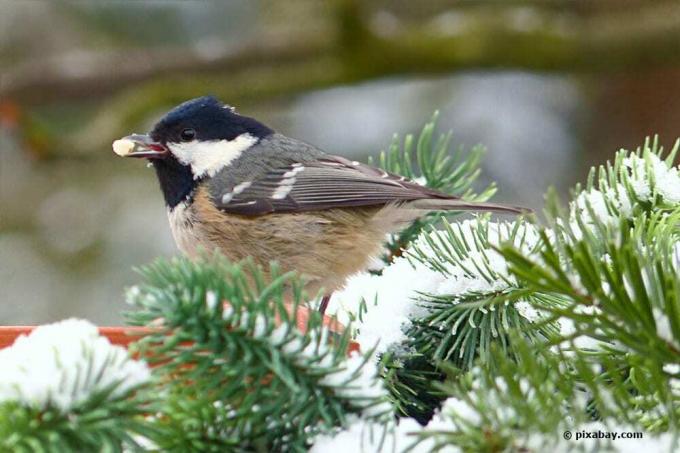
- Height and weight: 11 cm, 8 to 10 g
- Characteristics: black head, white cheeks and white patch on the neck, hardly any sex differences, young birds of the coal tit are pale, white patches are more yellowish
- Occurrence: is native to fir and spruce forests, sometimes also pine forests, outside of the breeding season also in deciduous forests, otherwise in gardens and parks with a dense tree population
- Food: Insects, larvae, conifer seeds, nuts, be crazy
- Brood: April to June, usually 2 broods per year, 5 to 12 eggs, nests in tree hollows, holes in the ground and wall holes, prefers nest boxes that are not too high
Willow tit - Parus montanus
Because it prefers swampy areas, the willow tit is less common than other tit species. This tit is very similar to the swamp tit.
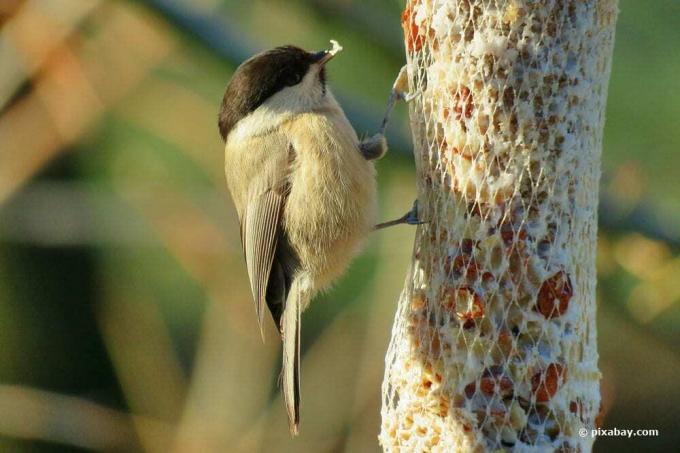
- Height and weight: 12 cm, 11 g
- Characteristics: black head with white cheeks, brown plumage, wings dark gray
- Occurrence: native of swampy deciduous forests, also in dry clearings in young forests, rarely in gardens or parks
- Food: Insects, spiders, small seeds
- Brood: April to May, one brood, 7 to 9 eggs, builds a cave in rotten deciduous trees
frequently asked Questions
How can tits be supported in the garden?
Not only titmice, but also other bird species benefit from nesting aids, feeding and watering points. They should always be set up or attached in such a way that they are safe for cats. It is also helpful if the garden is designed as close to nature as possible.
The main enemies of tits are cats and birds of prey such as hawks. Eggs and young birds are also prey for martens or even squirrels. To prevent woodpeckers from entering the nest box, a metal plate should be placed around the entrance hole. Humans also make it more difficult for tits to survive by using poisons in the garden, eliminating hiding places or fodder plants for insects or destroying breeding grounds.
Tits mainly eat insects and are therefore beneficial insects in the garden. Smaller tit species even sometimes eat aphids. Otherwise, caterpillars are also on the menu.



